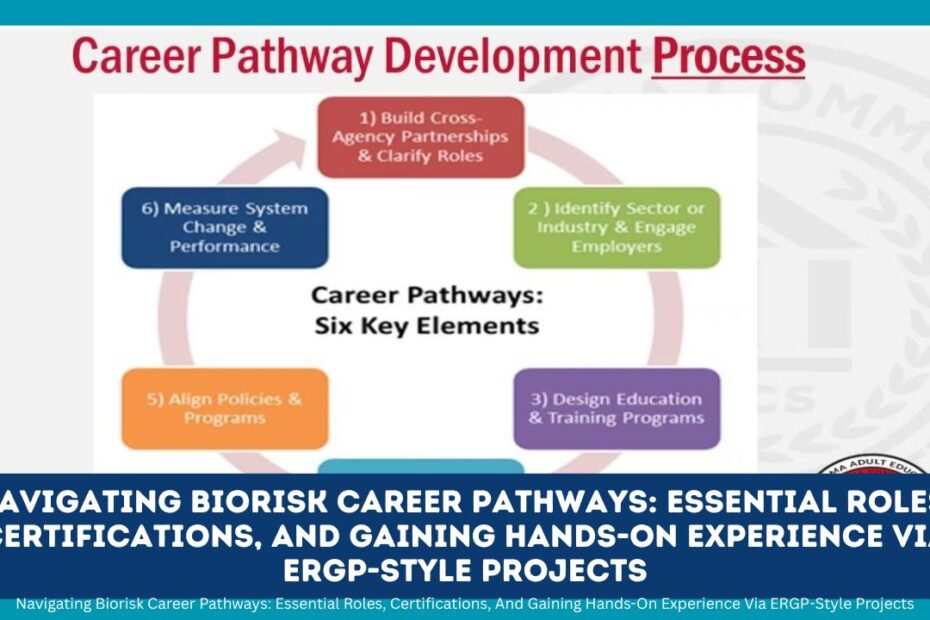In an era where biological threats—from pandemics to bioengineered hazards—pose escalating risks, pursuing a biorisk career can be both impactful and future‑proof.
This article explores the essential roles in the field, certifications to boost your credentials, and how hands‑on experience, particularly through ERGP‑style applied research, can accelerate your career.
Every detail, fact, and figure is grounded in current, verifiable sources—making this guide both realistic and actionable.
Essential Roles in Biorisk Career Pathways
Careers in biorisk span technical, policy, and operational dimensions. Prominent roles include:
- Biorisk Policy Analysts / Strategists – shaping regulation and preparedness, especially around engineered pandemics.
- Biosafety / Biosecurity Specialists – managing lab operations, risk assessments, and containment protocols in labs and facilities.
- Biorisk Management Advisors – conjoining scientific, safety, and organizational processes, integrating frameworks like ISO 35001.
- Applied Research Project Leaders – crafting field‑relevant studies, especially under programs like ERGP, tackling agricultural/zoonotic threats.
These roles are vital across universities, government, biotech, pharmaceuticals, veterinary settings, and NGOs.
Certifications and Credentials That Make You Competitive
Attaining the right credentials signals expertise and commitment:
- Biorisk Management Certificate (IUP): A 15–21 credit online or hybrid program merging biology and safety sciences. Funded partly by a $460,000 USDA grant, you can complete it in about a year and become competitive for entry-level biosafety roles across sectors. Externship opportunities, scholarships, and CEUs boost practicality and affordability.
- Professional Certification in Biorisk Management (IFBA): Internationally recognized, covering domains like ISO 35001, risk assessment, incident response, training, and documentation. Initial exam costs about $200 USD; recertification $150 USD, with discounted rates for resource-limited countries.
- ABSA International – Certified Biological Safety Professional (CBSP): The IUP certificate supports prerequisites for CBSP certification.
- ISO 35001 familiarity: A foundational standard in biorisk systems, often integral to technical roles.
Gaining Hands-On Experience via ERGP-Style Projects
Real-world projects solidify theoretical knowledge:
- ERGP Applied Research Grants: The Elizabeth R. Griffin Program (ERGP)—under Johns Hopkins Center for Health Security—offers funding (~$75,000 USD per institution) for applied biorisk research addressing critical evidence gaps in agricultural/veterinary biosafety and biosecurity. Areas include:
- Facilities Management: improvements in aerosol control, waste management, hierarchy of controls across labs.
- Workforce Development: training, personnel reliability programs, multidisciplinary curricula, insider threat detection.
- Innovation: green tech, risk communication, robotics, cybersecurity, remote field techniques.
- Projects involve clear experimental designs, cost-sharing (20% institutional match), and rigorous review periods (e.g., applications in Spring 2025 for funding July 2025–June 2026).
These efforts provide excellent hands-on learning, evidence-building, and networking opportunities within high-impact domains.
Comparative Overview
| Category | Program/Role | Key Details |
|---|---|---|
| Educational Certificate | IUP Biorisk Management Certificate | 15–21 credits, online/hybrid; USDA‑funded; externships, scholarships; 1 year |
| Professional Certification | IFBA Biorisk Management Certification | $200 exam, $150 recertification; ISO 35001 and operational competencies |
| Advanced Credential | CBSP via ABSA International | IUP certificate can support eligibility |
| Standard Knowledge Base | ISO 35001 Biorisk Management Standard | Covers risk assessment, response, roles, and auditing |
| Applied Experience | ERGP Applied Research Projects | Up to $75K funding; focus on facilities, workforce, innovation; 20% cost-share |
| Key Roles | Policy Analyst, Biosafety Specialist, Biorisk Advisor | Government, academia, biotech, vet/pharma, NGOs |
Strategic Pathway to a Biorisk Career
- Foundation Building: Begin with a relevant degree in biology, safety sciences, or related fields.
- Formal Training: Enroll in the IUP certificate—earn credits, access externships, and scholarships.
- Certification Credentials: After training, pursue IFBA certification, and then aim for CBSP.
- Acquire Standard Frameworks: Familiarize yourself with ISO 35001 and its domains.
- Practical Immersion via ERGP: Apply to or collaborate on ERGP‑style projects to gain applied research experience.
- Target Roles: With credentials and experience, explore jobs as biosafety advisors, policy analysts, and strategists across industry, academia, and government.
This layered approach ensures both theoretical mastery and practical impact readiness.
Navigating a biorisk career demands both formal qualifications and hands-on evidence-based experience.
By pursuing certificates from IUP, globally recognized professional credentials from IFBA (and aspirations toward CBSP), mastering ISO 35001, and participating in ERGP-style applied research, you equip yourself with the full spectrum of a high-impact career toolkit.
This combined pathway opens doors to vital roles across policy, operations, and strategy—empowering professionals to help safeguard global biosecurity in a world where it truly matters.
Frequently Asked Questions
1. What makes the IUP Biorisk Management Certificate stand out?
Its unique integration of biology and safety sciences, USDA funding (~$460K), externships, scholarships, flexible delivery, and alignment with CBSP make it accessible and career‑centric.
2. Is IFBA certification globally recognized and cost-effective?
Yes. It’s internationally accepted, covers operational domains and ISO 35001, and pricing is affordable—especially with discounts for professionals in low‑resource regions.
3. How does ERGP funding enhance practical experience?
ERGP supports targeted, applied biorisk research with significant funding (~$75K), focus on high‑consequence pathogens, structured reviews, and institutional collaboration—a powerful bridge between theory and real-world impact.

